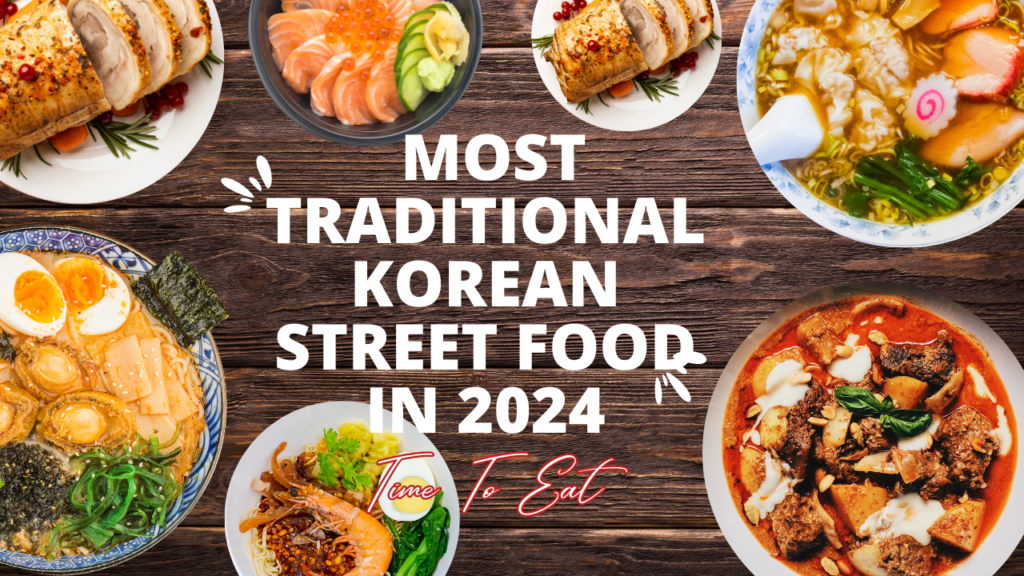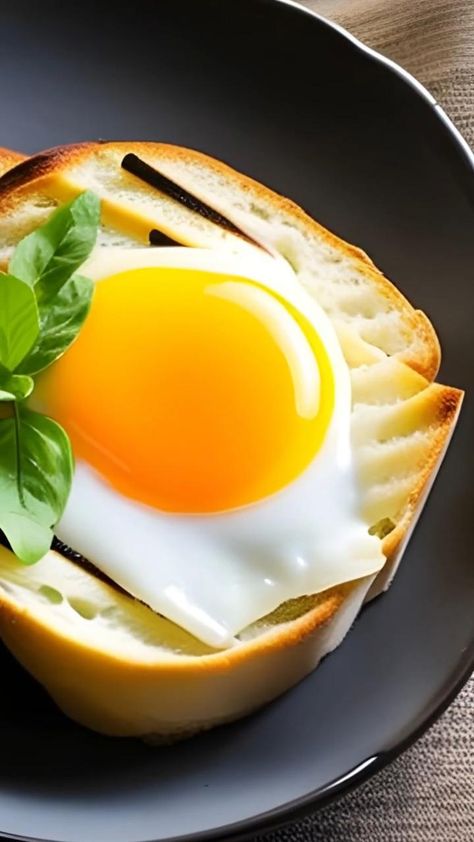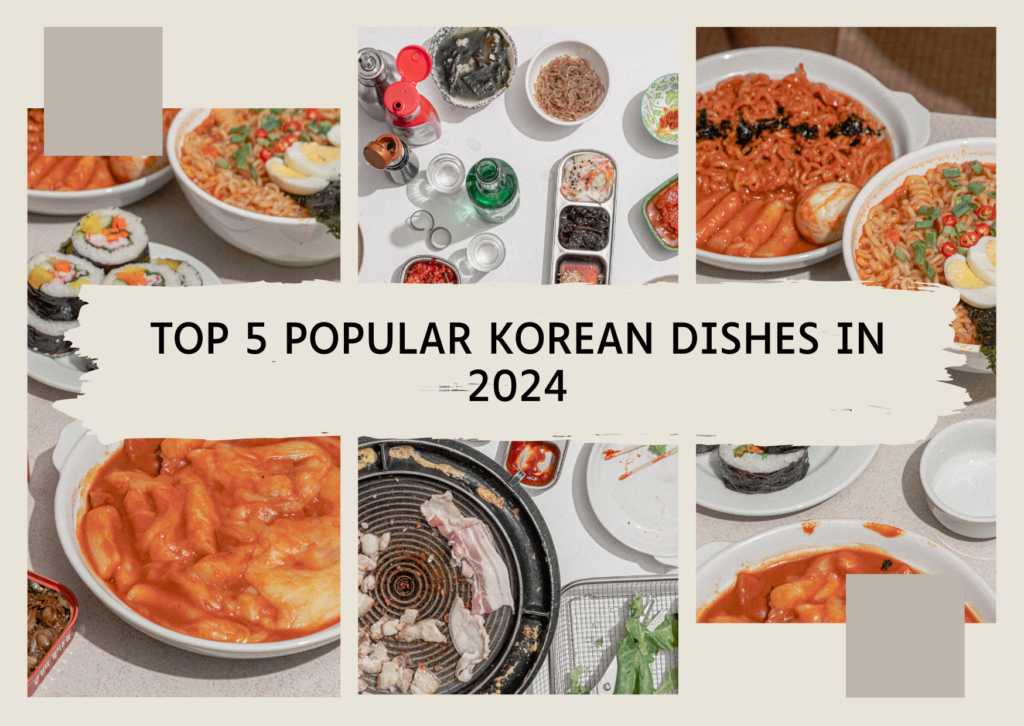The popularity of Korean street food
Korean street food has grown in popularity worldwide due to its diverse tastes, affordability, and cultural richness. Main dishes such as Tteokbokki, Hotteok (sweet pancakes), and Odeng (fish cake skewers) provide a unique and delicious experience that appeals to both locals and tourists. Vibrant street food culture, especially in Seoul’s busy neighborhoods like Myeongdong and Dongdaemun, highlights Korea’s culinary creativity and tradition.
The global fascination with Korean pop culture, fueled by K-pop and K-drama, has further fueled interest in Korean street food. Many street food stalls are featured in this popular media, attracting international fans keen to experience the food firsthand. In addition, the easy availability of Korean street food and the growing trend of food trucks and pop-up markets in major cities around the world have made these foods more accessible. The combination of bold flavors, cultural significance, and widespread availability continue to accelerate the popularity of Korean street food.

Traditional street food in korean
HOTTEOK/DEEP FRIED DUMPLING/KOREAN PANCAKES:
When it comes to hotteok, the Korean pancake game offers two main varieties: savory and sweet.
Let’s start with the savory option, which features a delightful combination of noodles and various veggies. The noodles are made from sweet potato starch, giving them a unique texture and flavor. This veggie pancake is known for its moistness and rich flavors, with the dough being particularly light and fluffy.
Now, onto the sweet hotteok. Prepare for a crispy delight that’s reminiscent of a donut. It’s coated in cinnamon, sugar, and a variety of seeds, adding a delicious crunch to every bite.
Whether you’re craving something savory or have a sweet tooth to satisfy, hotteok has you covered. With its versatile appeal and mouthwatering taste, it’s no wonder this Korean classic has captured the hearts (and stomachs) of food lovers worldwide. So why not treat yourself to a hotteok experience? Your taste buds will thank you!
EGG BREAD:

Ah, the delightful Korean egg bread, also known as “gyeran-bbang” (계란빵), is a street food gem adored by many in Korea. Picture a sweet, dessert-like bun that’s both comforting and satisfying.
Let’s break down the recipe: it’s a simple concoction of flour,
sugar, salt, baking powder, egg, and milk. Making it is a breeze, just two easy
steps. First, whip up a batter with flour, salt, and baking powder. Fill muffin cups three-quarters full with this mixture.
Now comes the magic. Crack an egg into a bowl, add milk and
sugar, and whisk away until smooth. Pour this heavenly blend atop the batter in
the cups, marrying the flavors together.
Pop them in the oven, and watch as they transform into golden-brown,
fluffy delights. With each bite, you’ll experience a perfect harmony of moist,cake-like bottom and creamy egg topping.
Having savored this treat myself, I can confidently say it’s a
taste sensation. The bottom layer resembles sponge cake, while the top is rich and eggy, with a delightful hint of sweetness and saltiness.
In essence, gyeran-bbang is like a Korean twist on the beloved
Portuguese egg tart. It’s the ideal snack for any occasion, whether enjoyed
with breakfast or as a pick-me-up during the day. It’s a true multitasker,capable of satisfying both hunger and cravings with ease.
So, next time you find yourself in Korea, be sure to indulge in some gyeran-bbang. It’s not just a snack; it’s a journey for your taste buds, a delightful reminder of the simple pleasures in life.
MANDU/ KOREAN DUMPLING:

Korean cuisine is rich with history and flavors, and one dish that encapsulates this beautifully is mandu, or Korean dumplings. With roots dating back centuries and a journey that spans from royal courts to bustling street stalls, mandu holds a special place in Korean culinary tradition. In this blog post, we’ll delve into the fascinating history of mandu, explore its diverse varieties, and even share a mouthwatering recipe that you can try at home.
The History of Korean Mandu:
The origins of mandu can be traced back to the Goryeo Dynasty (918-1392), where cultural exchanges with China introduced this delightful dish to Korea. Immigrants from China brought their culinary traditions with them, and Koreans infused mandu with their own style and taste, transforming it into a beloved part of their cuisine. Initially considered a royal dish enjoyed in the confines of the royal court, mandu gradually became more accessible to the general population over time. Today, it’s a ubiquitous street food found throughout Korea, enjoyed by people of all ages and backgrounds.
Varieties of Korean Mandu:
One of the most fascinating aspects of mandu is its versatility and variety. From steamed to pan-fried, sweet to savory, there’s a mandu for every palate and preference. The fillings and shapes of mandu vary across regions and seasons, reflecting local ingredients and culinary traditions. Some popular varieties include:
- Kimchi Mandu: Filled with a spicy and tangy mixture of kimchi and ground pork or beef.
- Mul Mandu: Boiled dumplings filled with tofu, vegetables, and sometimes meat, served in a comforting clear broth.
- Tteok Mandu Guk: A traditional Korean soup featuring sliced rice cakes and mandu in a clear broth, commonly enjoyed during the Lunar New Year holiday.
- Jabchae Mandu: Dumplings filled with japchae, a Korean dish made from sweet potato noodles stir-fried with vegetables and meat.
- Gun Mandu: Large, pan-fried dumplings with a crispy exterior and a savory filling of meat and vegetables.
Again, there is no barrier for filling; if you want to add some more items according to your taste, there is no boundary. Now let’s talk about its recipe.
- In a large mixing bowl, combine ground meat, chopped cabbage, green onions, carrots, tofu (if using), minced garlic, soy sauce, sesame oil, sugar, salt, and pepper. Mix well until all ingredients are evenly distributed.
- Take a dumpling wrapper and place about 1 tablespoon of the filling mixture in the center.
- Moisten the edges of the wrapper with water using your finger.
- Fold the wrapper over the filling to create a half-moon shape, pressing the edges together to seal. Crimp the edges with a fork to ensure they are tightly sealed.
- Cook the mandu by steaming, boiling, pan-frying, or deep-frying according to your preference.
- Serve hot and enjoy with your favorite dipping sauce!
I recently tried making mandu at home using this recipe, and it turned out fantastic! I made a batch of mandu for a family gathering, and they were a huge hit with both kids and adults alike! The recipe was straightforward and yielded a generous amount of dumplings. I appreciated how customizable the filling was – I added extra veggies to sneak in some nutrition for the kids. Everyone raved about how tasty they were, and they were gone in no time. Will definitely be making these again for future gatherings!
Mandu is more than just a dumpling – it’s a culinary journey through Korea’s rich history and diverse flavors. Whether enjoyed as a snack, appetizer, or main dish, mandu brings people together and delights taste buds with its delicious fillings and comforting textures. So why not try making your own mandu at home and experience the magic of Korean cuisine firsthand?
KOREAN STREET NOODLES:

Korea’s vibrant street food scene has always held a special place in my heart.
Today, we are going to talk about the most common yet the most favorite cuisine of Korea. Yes, you guessed it right – I’m talking about Korean street noodles. Once again, filled with endless variety, these noodles are a staple of Korean street food culture and a beloved choice among locals and visitors alike.
From classic favorites like jjajangmyeon to innovative creations like bibim guksu, there’s a noodle dish to satisfy every craving and delight every palate.
One of my go-to choices is jjajangmyeon, a beloved Korean-Chinese dish featuring thick, chewy noodles smothered in a savory black bean sauce. With diced pork, onions, zucchini, and potatoes adding layers of flavor and texture, it’s a hearty and comforting meal that never fails to hit the spot.
But my love affair with Korean street noodles doesn’t end there. I’ve also developed a fondness for bibim guksu, a spicy mixed noodle dish that’s as refreshing as it is flavorful. Tossed in a vibrant sauce made from gochujang, vinegar, sugar, and sesame oil, and topped with fresh vegetables and sliced eggs, it’s a symphony of sweet, savory, and spicy flavors that dance on the tongue.
And let’s not forget about kalguksu, those hand-cut noodles served in a clear broth alongside vegetables and sometimes seafood or meat. With each slurp of noodles and sip of broth, I’m transported to a place of warmth and nourishment, a comforting embrace on a chilly day.
But perhaps what I love most about Korean street noodles is their ability to tell a story – a story of Korea’s rich culinary history and vibrant food culture. From ancient times to the present day, noodles have been a staple of Korean cuisine, evolving and adapting to meet the changing needs and tastes of the population.
As Korea underwent periods of urbanization and industrialization in the 20th century, the street food scene evolved alongside it, with noodle vendors becoming a common sight in bustling marketplaces. Today, you can find a diverse array of street noodles in Korea, each offering a delightful array of flavors, textures, and styles.
Whether enjoyed as a quick snack on the go or as a hearty meal at a bustling night market, Korean street noodles are a beloved culinary tradition that continues to delight and inspire food lovers like myself. So the next time you find yourself wandering the streets of Korea, be sure to follow your nose – it just might lead you to the best bowl of noodles you’ve ever tasted.
So, do you want some rameyon? Kidding!!
DALGONA/ KOREAN SUGAR CANDY:

The history of dalgona, a popular Korean sugar candy, is quite fascinating. Dalgona has its roots deeply embedded in Korean culinary tradition and has been enjoyed for generations. While the exact origins of dalgona are not precisely documented, it is believed to have been introduced to Korea during the early 20th century.
Dalgona initially gained popularity as a simple homemade treat made with just sugar and baking soda, cooked over a stovetop until it caramelized and hardened into a sweet, crunchy candy. It was a favorite among children and adults alike, often enjoyed during festive occasions or as an everyday indulgence.
Over time, dalgona evolved and adapted to changing tastes and preferences. Today, it is not only cherished for its nostalgic appeal but has also become a trendy confection enjoyed by people of all ages. Modern variations of dalgona incorporate additional ingredients such as honey, malt syrup, or cocoa powder, adding depth to its flavor profile and creating new and exciting twists on the classic treat.
In recent years, dalgona gained international fame thanks to a viral social media trend that showcased a whipped coffee drink bearing the same name. This modern take on dalgona features a frothy layer of whipped coffee atop milk, creating a visually stunning and delicious beverage that captivated people around the world.
Whether enjoyed in its traditional candy form or as a trendy coffee concoction, dalgona continues to hold a special place in Korean culinary culture and remains a beloved treat cherished for its sweet flavor and nostalgic charm.
Now, if you’re feeling adventurous and want to try making dalgona at home, here’s a simple recipe you can follow:
In a clean, dry saucepan, add the granulated sugar.
- Heat the sugar over medium heat, stirring constantly with a wooden spoon or silicone spatula.
- Continue to heat and stir the sugar until it melts completely and turns into a golden-brown caramel.
- Once the sugar has caramelized, remove the saucepan from the heat.
- Quickly stir in the baking soda until it is fully incorporated into the caramelized sugar. Be careful as the mixture will bubble up.
- Pour the hot mixture onto a baking sheet lined with parchment paper or a silicone mat.
- Use a spatula or the back of a spoon to spread the mixture into an even layer.
- Allow the dalgona to cool and harden for about 30 minutes to an hour.
- Once the dalgona has cooled and hardened, break it into bite-sized pieces or use cookie cutters to create fun shapes.
- Enjoy your homemade dalgona as a sweet treat or gift it to friends and family!
You can also experiment with different variations of dalgona by adding cocoa powder or instant coffee for a unique twist. Have fun and enjoy the delicious taste of homemade dalgona!
Why people love to eat Korean street food
People enjoy traditional Korean street food for its diverse flavors, convenience and cultural authenticity. A variety of dishes, such as teokbokki (spicy rice cakes), hotteok (sweet pancakes), and odeng (fish cake skewers), offer a unique culinary experience that caters to a variety of taste preferences. The bold and vibrant flavors, often combining sweet, spicy and savory ingredients, are a major attraction for food enthusiasts.
Traditional Korean street food is also super convenient, making it an ideal choice for busy people looking for a quick and satisfying meal. Busy street food stalls in places like Myeongdong and Dongdaemun provide a lively atmosphere, allowing people to enjoy their food while soaking in the local culture.
Additionally, the affordability of traditional Korean street food makes it accessible to everyone from locals to tourists. The combination of delicious flavors, cultural immersion, and convenience ensures that traditional Korean street food remains a popular and cherished part of Korea’s culinary landscape.


